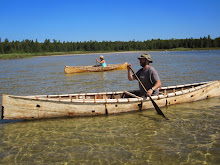I think that I would be more comfortable traveling nude in an Alaskan blizzard than walking into the woods without my trusty diamond sharpener tucked safely in the side pocket of my pants. I never thought I would have the occasion to do either until I recently committed myself to a week long trip without taking any manufactured sharpening gear. My intent was to learn to use only what I found in the wild for my honing needs, and to add another item to my list of bushcraft and survival skills.
While reading the 1891 journal of famed Alaska explorer Frederick Schwatka, I ran across a passage where his group had shot a moose to supplement their dwindling rations. Before butchering the moose, his Indian guide spent over an hour looking for a “proper stone” to sharpen his knife. In another old journal, Eskimo carvers were having a good laugh at white traders who had carried whetstones from New York to western Alaska by train, then steamship, then dory to use as trade items. The carvers quickly proved that the stones they had found in nature were far superior to the ones offered as trade. This convinced me that staying naturally sharp was a viable idea. Soon I was off on a foray in the Bush (gulp) with no commercial sharpening gear whatsoever.
We arrived in camp on the southern tip of Kodiak Island. As is the usual case, someone borrowed my knife and then someone else, and soon it was time to dress the edge. As I began my search, it was apparent that natural stones rarely provide a flat surface, and that most are so rough that they just make matters worse. However, the smooth stones found in riverbeds, on ocean beaches and in glacial till provided a solution. By holding the blade still and making circular motions with the smooth stones, a decent edge was achieved. It was a slow process compared with modern diamond sharpeners, but I was pleasantly surprised with the results. I learned that almost any somewhat smooth stone would in time produce a suitable edge, even on high-tech stainless steels.
By using a succession of three stones of differing coarseness and my belt for a strop, I was eventually able to shave a patch of hair off of my arm. The slowness of the process was due in part to the softness of the finish stones, but was also likely due to their rounded shape, which allowed only a small portion of the stone to touch the blade at any one time. This has a clear parallel in manufactured products, as a flat, diamond bench hone works much faster than a round diamond stick of the same grit.
The most aggressive stones were made up of different varieties of quartz. Quartz would be somewhere in the 70’s on the Rockwell scale, so it easily cuts blade steel. The quartz stones glazed over with metal particles in a short while, and no amount of water would slow the glazing, but there were plenty of the rocks available to replace the glazed ones. The softer shale put on the finest edge, but it was the quickest to glaze over.


In later travels to the Continental US, I followed the advice of an Oklahoma elder who told me that common sandstone would not glaze over, especially when water is used for a lubricant. She had sharpened her kitchen knives on her sandstone back steps for over a half century. I have now sharpened my own kitchen knives on sandstone for the past few months and find that although the process is labor intensive, the edge produced is approximately equivalent to that of a 600 grit diamond hone. The glazing is avoided because, as with Japanese water stones and soft Arkansas stones, the surface wears down, continually exposing fresh abrasive material.
To achieve the best possible edge, stropping is a must. Without the strop an otherwise sharp knife can perform the same as a really dull one. The purpose of the strop in this case is simply to remove the wire edge that forms while working on the stone. There are many options that will serve well as a strop. Of course the back of a leather belt works fine. Choices also include canvas (I use the leg of my work pants) dry cardboard, boot tops, nylon strapping and so on. The formal woodcraft schools in Europe have even taught stropping on the palm of the hand to attain the finest edge. (Do not try this at home without adult supervision.)
A dependable, modern sharpening system should always be a part of every outdoor kit; however, a basic premise of bushcraft is to learn to use what nature provides. It is good to know that, with practice, there are alternatives to manufactured products.




